
Preparing for Future Rounds
While in Round One, a total of 88 companies from 21 countries participated, Round Two attracted 53 participants from 20 countries. At first blush, the reduced number of participants from one round to the other may seem like a bad sign, even more so considering that Round One saw an average of 5.3 offers per block, while Round Two invited an average of 2.6 offers per block.
But beyond the number of participants, Round One assigned 34 out of the 50 blocks on offer, meaning a 68 percent allocation rate. In contrast, Round Two assigned 73 percent of the 68 blocks placed for allocation. This shows the nuances present in the licensing rounds and the need for pronounced analysis to measure the true success of each one.
In terms of learning curves and the actual mechanism of the bidding processes, there has been a clear improvement since shallow water Round 1.1, when only two blocks out of 14 were awarded. In comparison, Round 2.1, also in shallow waters, allocated 10 out of 15 available blocks. The number of participants also increased from nine to 20 from Round 1.1 to Round 2.1. The improvement can also be seen in the total acreage allocated, with a total of 55,563km2 in Round Two, dwarfing the 20,456km2 allocated in the previous round.
ROYALTIES AND COMMITTED INVESTMENT
In Round 1.1, the Ministry of Finance did not reveal the minimum royalty required from the bidders prior to the tender, meaning that bidding companies did not have a solid foundation on which to base their offers. This impacted greatly impacted the success of the round as a number of bids failed to satisfy the minimum royalty requirements, meaning that blocks were not allocated as a result. Such was the case of Block 3 where the consortium conformed by Murphy Oil and PETRONAS offered an additional royalty of 35 percent. This was below the nonpublished minimum additional royalty of 40 percent. Blocks 4, 6 and 12 suffered similar fates. Round 1.1 had an assignation rate of just 14 percent largely for this reason.
From Rounds 1.1 to 1.4, additional royalties offered to the state ranged from 5-85.69 percent, with an average of 43.39 percent. From Round 2.1 to 2.4, the figures ranged from 3.91-75 percent, with an average of 30.75 percent. In addition to the maximum and minimum royalties required, the increased stability of the rounds can also be seen in the government take in each block. From Round 1.1 to 1.4, the state’s total participation ranged from 59.8 to 90 percent, while from Round 2.1 to 2.4 it ranged from 64.7 to 83.9 percent. According to Gaspar Franco, Commissioner at CNH, the overall success of the rounds was a result of the positive evolution of the auction regulations. “We have adopted the feedback from previous rounds to perfect the future rounds, such as adding the state’s minimum and maximum royalty requirements to ensure realistic offers,” he explained.
Another result of the scheme implemented at the beginning of Round Two was the appearance of ties among companies interested in investing in the country, and the subsequent payments required to break those ties. The round saw over US$642.8 million in tiebreaker payments to FMP coffers.
Estimated investment coming from the rounds can arguably be the main indicator of the attractiveness of the rounds. To that end, Round Two also proved itself more attractive than Round One, bringing US$102.9 billion in investment compared with the US$40.8 billion in the previous.
FARMOUTS
PEMEX’s farmouts have also gathered a great deal of attention since CNH named BHP as PEMEX’s first partner in deepwater block Trion in a new association scheme. During the bidding process that took place on March 3, 2017, both BHP and BP placed bids for the farmout. Both BHP and BP committed to drilling two additional exploratory wells and each offered an additional royalty of 4 percent to the government. When the upfront tiebreaker payments were revealed, BHP emerged victorious with a cash payment of US$624 million, making the Australian oil and mining giant the first farmout partner in PEMEX’s history.
The allocation of onshore farmouts Ogarrio and Cárdenas-Mora came down to six and three operators, respectively. After the bidding processes, DEA Deutsche became PEMEX’s partner for Ogarrio and PICO Cheíron was selected for Cárdenas-Mora. Pedro Joaquín Coldwel.
STAGE OF ASSIGNED CONTRACTS
Minister of Energy, highlighted the importance of PEMEX’s farmouts for the country: “These three farmouts represent investments of US$7.8 billion, or 72 percent of PEMEX’s capital investment for 2017."
The conditions for Ayin-Batsil and Nobilis-Maximino were not attractive enough for potential partners, resulting in CNH declaring both farmouts deserted. PEMEX, therefore, must work on the terms and conditions of these JOAs to increase the attractiveness of the fields. Still, CNH and PEMEX have already announced seven onshore blocks ready to be farmed out in the states of Veracruz, Campeche and Tabasco. Alma América Porres, Commissioner at CNH, has faith in the successful development of these areas but says a positive relationship between PEMEX and its potential partners will be crucial. “I firmly believe that these are exciting areas with a lot of potential,” she adds. “However, the development of these areas depends on the rapid adaptation of the current market conditions.”
THE RESULTS
As of April 2018, exploration plans for Round One awarded blocks state that five areas will be in the exploration phase, nine areas will be in the appraisal phase and 15 in the appraisal and development phases by the end of 2019. A total investment of US$1.38 billion will be deployed in those areas by the end of that year. Meanwhile, seven areas from Round Two are reported to be in the appraisal phase also by the end of 2019, with a total investment of US$19.26 million already deployed. As investment has increased, the income for the state due to contracts has also multiplied. In 2017, state coffers accrued US$339 million from E&P contracts, 18 times the amount received in 2016.
Héctor Moreira, Commissioner at CNH, recognizes the improvement of the licensing rounds. “Over time, the licensing rounds have grown in number of blocks awarded, their optimization, the awarding of agreements, the number of bidding companies and the amount of money offered above the previously stipulated royalty, which is an indicator that we are moving in the right direction,” he says. Fellow CNH Commissioner Gaspar Franco concurs: “We believe that every licensing round has been successful because they have pushed up investment, increased the number of new operators, extended the acreage awarded for exploration and production and they are resulting in a larger number of new contracts,” he says. “Every licensing round has been increasingly competitive as each has raised Mexico’s attractiveness, illustrating the private sector’s confidence in the industry.”
While much of the credit for the success can be given to the Mexican regulators and policymakers and to the attractive schemes they have laid out for the licensing rounds, Moreira likes to highlight the importance of an open market in achieving such success. “There is an interesting relationship between the Ministries of Energy, Finance and Economy, PEMEX and CNH in which they provide advice on these processes,” he says. “But the ultimate player in setting the requirements is the market and its behavior, so market analyses and the study of awarded areas are key to successful licensing processes.”
















